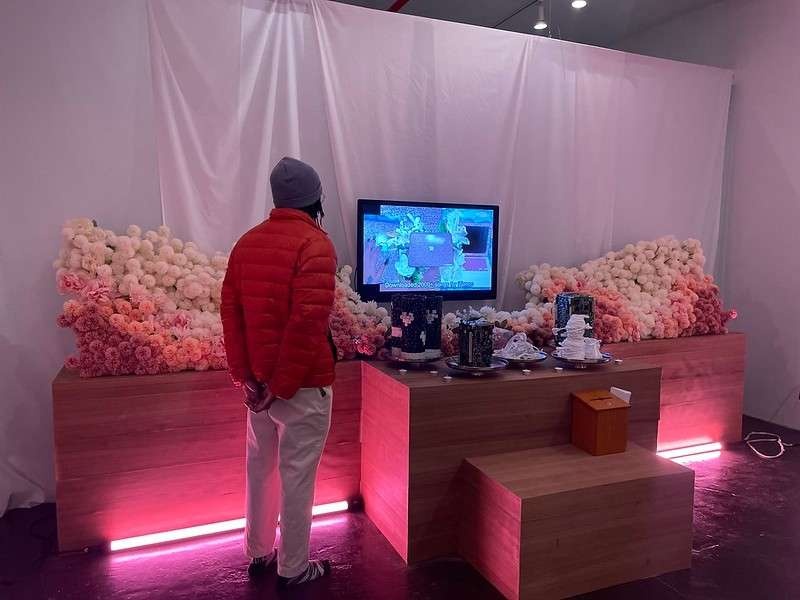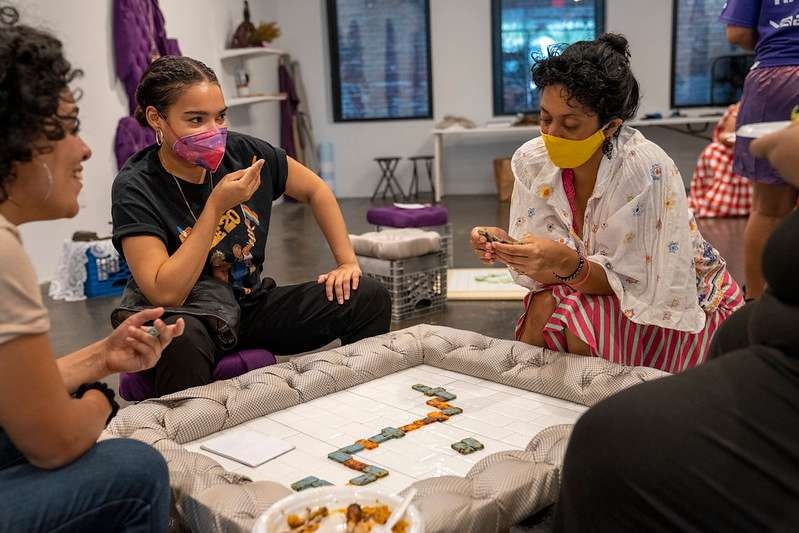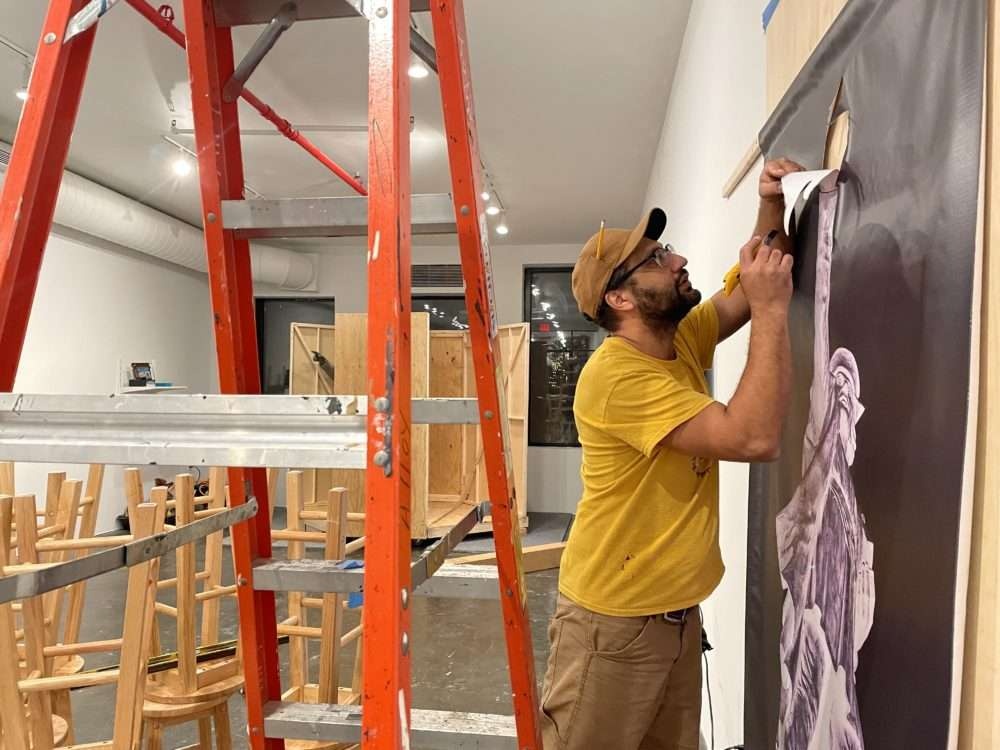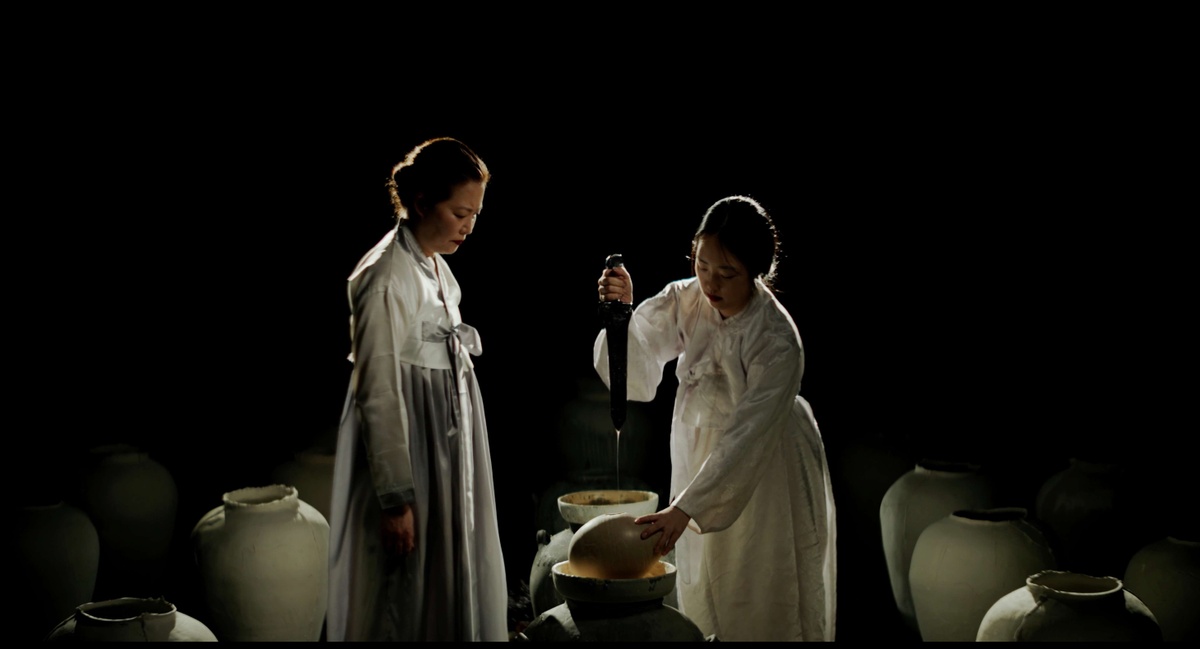

Introduction
One night, a woman had a dream in which she was at the top of a mountain overlooking the predynastic Korean kingdom of Silla. She began to urinate so copiously that she soon flooded the city below. The next morning, she shared the dream with her younger sister, who offered to purchase it in exchange for a silk skirt. This younger sister would go on to meet, marry, and have sons with a man who would come to be the King of Muyeol of Silla and unite the three kingdoms of Korea.
This continued tradition of buying and selling dreams and the shared, worldwide phenomena of dream changes during the pandemic form the basis for AYDO’s multiphase, process-based Session at Recess, Offering of Dreams. A collaboration between the artists Ayoung Yu and Nicholas Oh, AYDO utilizes performance-based film and sculptural installation to reimagine precolonial Korean folk and spiritual practices within the contemporary sphere. Drawing upon the artist’s backgrounds in dance, ceramics, and film-based storytelling, their work centers individual and shared diasporic perspectives. During the isolation of the COVID-19 lockdown and the surge in anti-Asian hate crimes, Yu and Oh began collecting dreams from Asian American immigrant communities, loved ones, and collaborators. The artists exchanged a hand-thrown porcelain vessel for each, eventually building an archive of these purchased dreams.
Unfolding over the course of five weeks between March and April 2023, Offering of Dreams drew from this archive to transform Recess’s space into a dynamic theater for staging and exchanging dreams. Rich with the scents and textures of mulch, fermenting vegetables, and trickling water, the environment was a constantly evolving space for the artists and visitors alike to explore the capaciousness of shared dreamscapes. Past projects by the artists have involved performances of reinterpreted traditional rituals in settings including the Hudson Valley, Hawai’i, and the Demilitarized Zone (DMZ) between North and South Korea, probing the translations and reconfigurations of ancestral connection inherent to these shifts in site. At Recess, Offering of Dreams expands this research, viewing dreams through this diasporic lens and treating their terrain as stages for the renegotiation of ancestral and syncretic traditions.
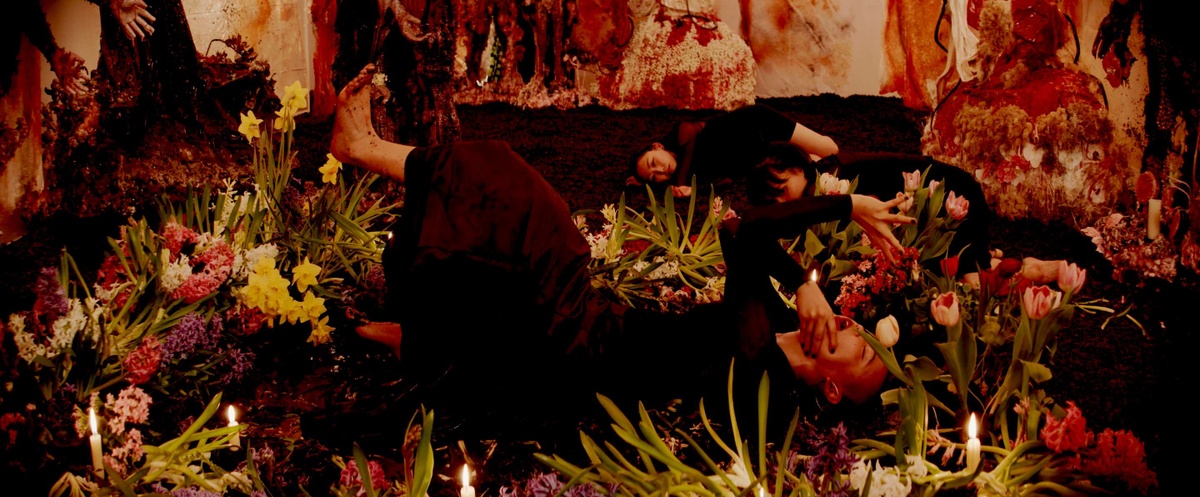

AYDO, still from film shot during Offering of Dreams, 2023.
Colliding Dreams
The footage filmed during Colliding Dreams, the first iteration of Offering of Dreams, gleams red with the luminous glow of flesh, flowers, and gochugaru, Korean red pepper flakes, dusted across the backdrop. In the foreground, dancers improvise ritual-based movements to a soundtrack that fuses various shamanic sounds and chants. The artists staged this live performance both as an ephemeral event open to visitors and as a film that was projected in the concluding event of the project. This collaborative and multistage process is emblematic of AYDO’s practice, in which layers of installation, performance, and dialectical exchange coalesce in narrative films.
These scenes are shot in a site-specific installation that emerges directly from Yu and Oh’s bodies and dreams, recording and remixing their bodies through 3D-printed replicas of their bodies, digitally altered to “collide” and merge. The film also incorporates fragments of past performances, such as personal ceremonial garments worn during ancestral rituals performed at the DMZ. Indeed, many of the organic materials within the installation reference the DMZ’s biodiverse wildlife, providing glimpses into two otherwise inaccessible landscapes—that of the heavily-guarded border, and that of personal dreams.
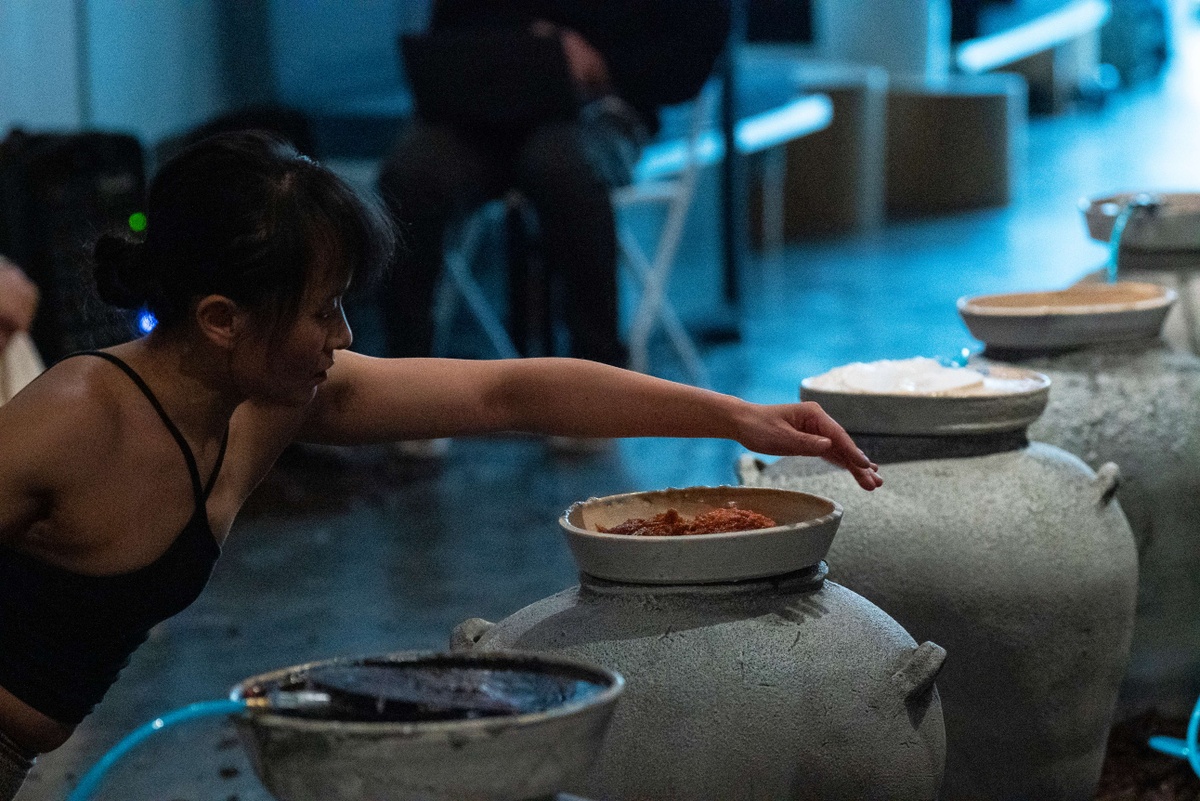

Performance view, Fermenting Dreams, 2023. Photo: Manuel Molina Martagon
Fermenting Dreams
Whereas Colliding Dreams took Yu and Oh’s dreams as their point of departure, Fermenting Dreams engaged with multigenerational, matrilineal dreams across three generations: Yu, her mother, and her grandmother. The installation and performance foregrounds the onggi, a traditional Korean fermentation vessel. The highly-functional onggi recalls the form’s long history across time and geography, including Yu’s own memories of burying fermentation vessels with her mother and grandmother in her family garden in the suburbs of New Jersey. The sharing of food and processes of fermentation stand in for the processes of cultural inheritance, intergenerational knowledge transfer, and the translations that occur throughout transpacific travel. Like with Colliding Dreams, the site-specific installation was used in multiple ways for gathering, performing, and filming. The resulting film featured a performance between Yu and her mother based in their dreams, exploring the overlaps and gaps between two women who immigrated to the US at vastly different ages and times.
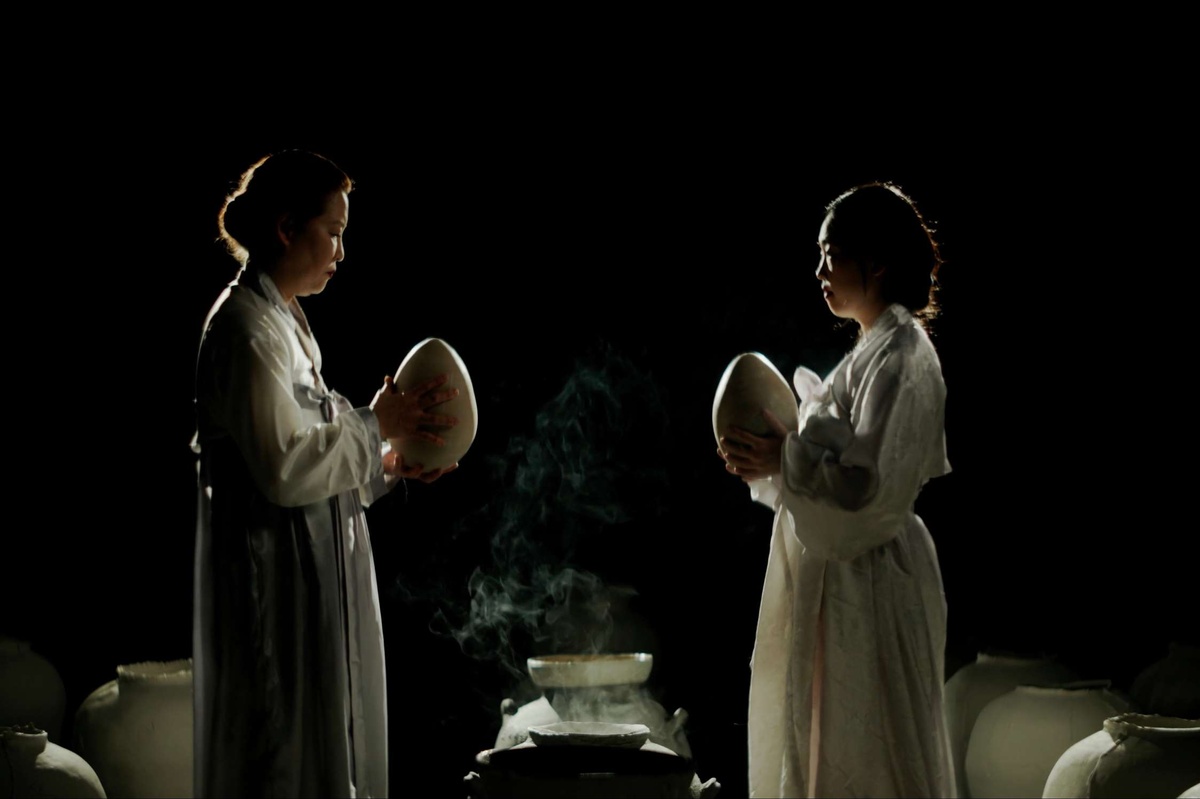

AYDO, still from film shot during Offering of Dreams, 2023.
Digital Shamanism
AYDO often reimagines Korean shamanic rituals in their performances and films, refashioning them for contemporary sociopolitical and diasporic contexts. For the third turnover of the space, Digital Shamanism, the artists collaborated with New-York based shaman Mudang Jenn, exploring her dreams and Muism, the ancient and enduring religion indigenous to the Korean peninsula. Together, they experimented with an AI-based form of shamanic divination in which subjects select colored silk flags to be read by a shaman. By substituting an AI algorithm trained on Mudang Jenn’s readings, the artists expand otherwise intimate and secret practices, providing space for the communal and universal.
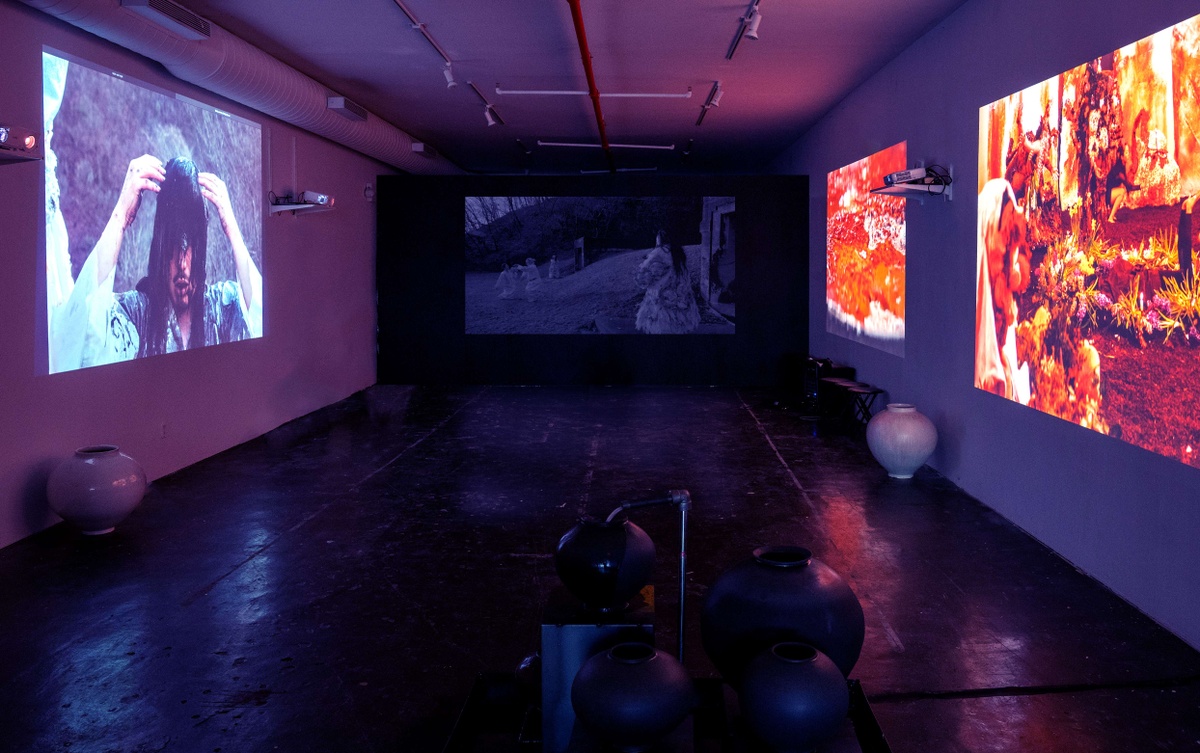

Installation view, Offering of Dreams, 2023. Photo: Manuel Molina Martagon
Closing Installation
For the closing installation, AYDO interpolated the filmic spaces of past performances with the physical space via large-scale projections of the films produced throughout their Session. In the center of the gallery was a fountain constructed from a series of moon jars. Unlike the onggis used in Fermenting Dreams, over years of colonization and war, the moon jar has become alienated from its original function and cultural significance. AYDO’s asserts a communal reclamation of the moon jar as a sacred vessel, welcoming guests to offer personal dreams inscribed on water-soluble paper. Like unglazed ceramic dissolving in water, the rice paper quickly dissipated, churning the shared dreams into a collective pulp that could be dried, recycled, and reformed into new material.
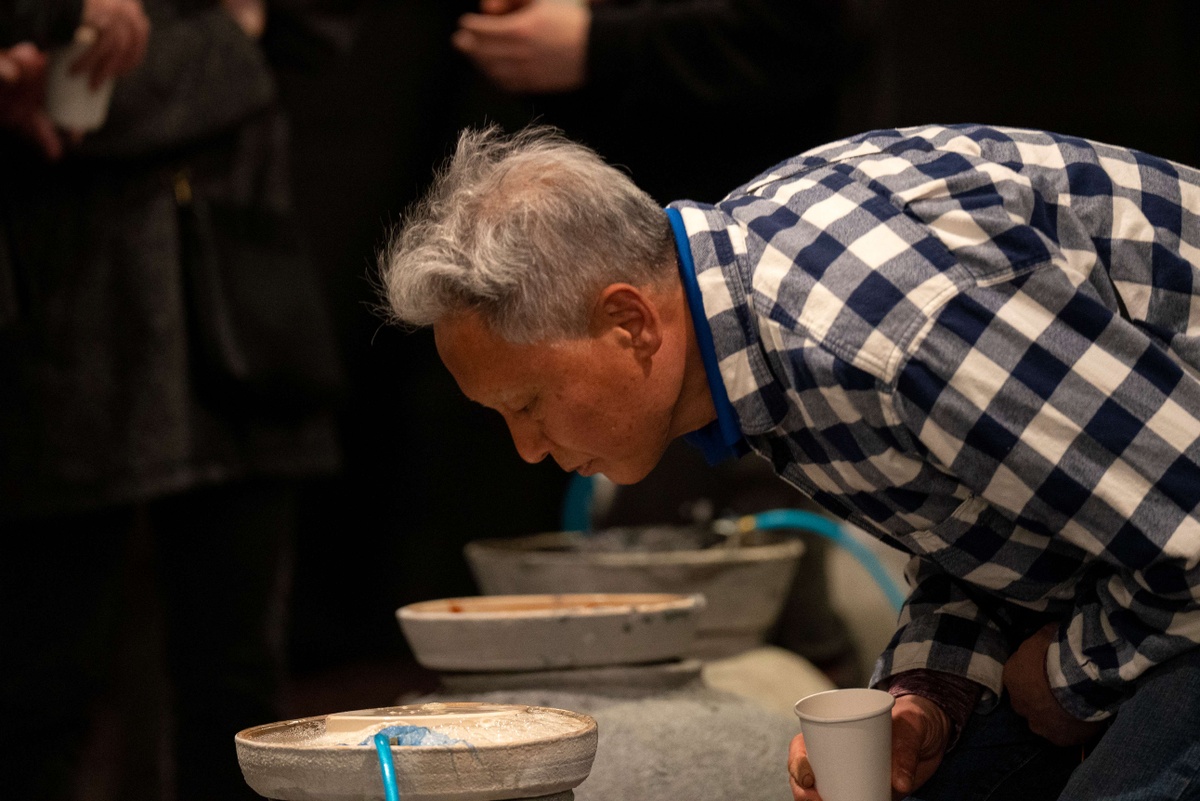

Performance view, Fermenting Dreams, 2023. Photo: Manuel Molina Martagon
Conclusion
A dream shared by Yu’s mother, Seong Sil Lee, recounts, “A black leopard and a spotted leopard emerged out of a small basket filled with flowers in varying stages of bloom. I was cradling this basket very close to my chest, fearing someone would take it from me. The leopards, now slowly shrinking to the size of my palms, crawled next to my eldest sister whom I haven’t seen for many seasons. My sister, who was lying down on the mat on the floor, immediately leapt up and gathered the tiny leopards in her palms. She carefully tucked them into her purse–smiling and whispering to them. When I called out to her, I realized she already disappeared into the shadows. The flowers in my basket turned into seeds.” Simultaneously ephemeral and permanent, experimental and ancient, and collaborative and individual, AYDO’s Session Offering of Dreams generates these seeds from the flowers of shared dreams—nascent kernels of future projects and new forms of relation.
About the artist
Alison Guh
Writer


Alison Guh is a curator, art historian, and writer based in New York and Los Angeles. Interested in transnational networks of modern and contemporary art, she received her M.A. in Modern and Contemporary Art (MODA) from Columbia University and her B.A. in Art History and Psychology from Dartmouth College. She has held positions and internships at The Museum of Modern Art; the Hood Museum of Art; and the Peggy Guggenheim Collection.
Explore/Archive
See allSeptember 2023
Chinyere Okafor
written in conjunction with artist Suhyun Choi's Session project, Memorial for Laptop.
June 2023
Everyday Objects, Complicated Histories
Kleaver Cruz
written in conjunction with artist Francheska Alcántara's Session project, Secure the Bag, Mint the Soaps and Throw the Bones.
March 2023
Lisa Hsiao Chen
written in conjunction with artist Jean-Marc Superville Sovak's Session project, Can a Sculpture feel Pain?/ Columbus Confessionals.
